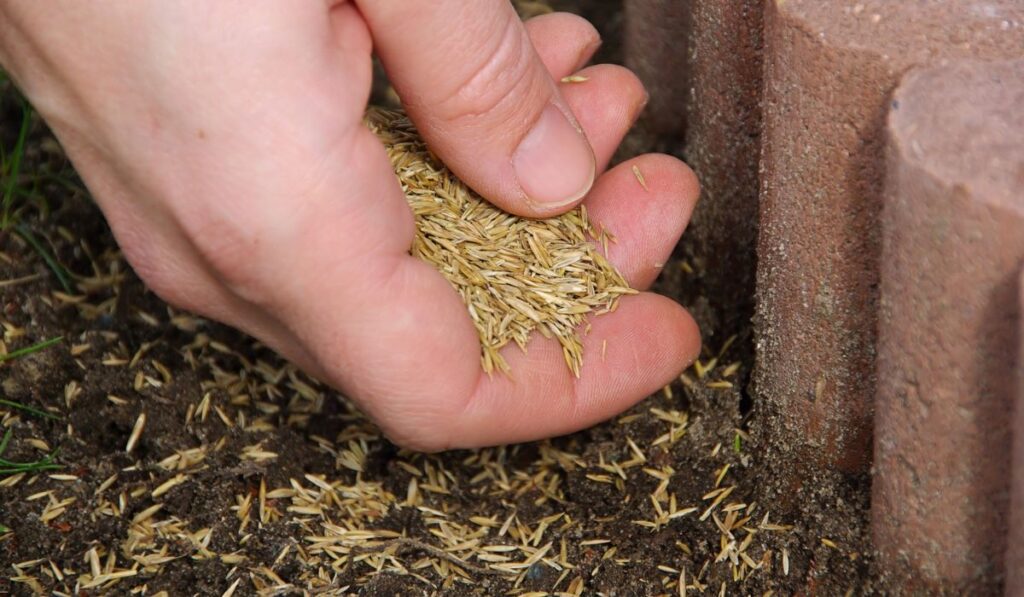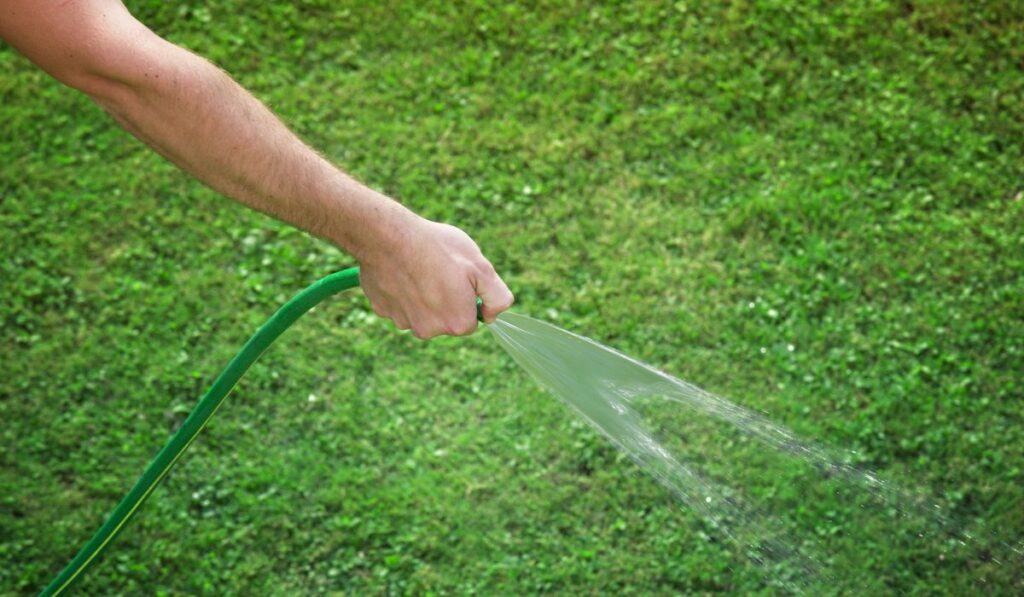Grass is one of the most common plants grown worldwide. Whether it’s lawn grass or hay for animal feed, who knows what our world would look like without it? But when’s the ideal time to plant grass, and how do you maintain it properly?
The best time to plant grass seed is in fall for cold-season varieties and in late spring for warm-season varieties. Grass grows best in neutral or slightly acidic soil that’s nutrient-rich, so test its pH beforehand. Under proper conditions, grass seedlings will appear after seven to 14 days.
Let’s look at the best time to plant grass seed, how to prepare the soil for planting, and how to protect the grass seedlings. We’ll also discuss tips for keeping your grass healthy.
What is the Best Month to Plant New Grass Seed?

The best time of the year to plant new grass seed is late spring or early fall, but this depends on the grass variety, the climate in your area, and where you’re planting the grass. Grass grows best in full sun, and the seedlings need to establish themselves when the temperature is moderate.
While some types of grass will grow best in the spring or fall, nearly all grass will grow optimally when the weather is moderate. Grass more suited to colder climates will then establish itself better in the fall and winter, while grass grown in the spring will establish itself in the summer.
Spring and fall don’t come in the same months in all climates, either. In the warmer southern states, spring will start as early as late January or February, and in the colder northern climates, the weather will only start getting warm around April or May.
Regardless of which grass variety you’re planting, you’ll have to adjust the sowing month according to your local climate.
However, no grass type should be planted in the winter or summer as extreme heat and cold can damage the seedlings. Even if you’re planting cold-resistant grass, try planting it in the fall when the weather still has some warmth, so the seedlings don’t get affected by early frosts.
Once the grass matures, it will be able to handle more extreme temperatures without dying. However, this depends on the grass variety and the growing conditions that help it become established in the soil.
Cool-Season Grass vs. Warm-Season Grass
Cool-season grass grows better in colder climates and will become established in the fall, while warm-season grass requires higher temperatures and full sunlight to grow. You can plant any variety on your lawn, but it’s best to choose one that matches your local climate and temperature conditions.
The main difference between cool-season and warm-season grass is the soil temperature they need to germinate and grow. Cool-season grass seeds can germinate when the soil’s temperature is below 65 F, while warm-season varieties need the soil temperature to be 65 F or higher to germinate.
The growing conditions, growth style, and other growing requirements also vary amongst cold- and warm-season grass.
When to Plant Cold-Season Grass
Cold-season grass should be planted in the fall when the temperature starts dropping, but it’s not cold enough to damage the grass seedlings. This is often 40 to 50 days before the first frost, which is enough time for the grass to become established before winter. Cold-season grasses are durable and can resist below-freezing temperatures, but they won’t grow in such conditions.
One advantage of planting grass in the fall is that the roots will already be established when spring arrives, giving it an advantage over weeds. However, if you plant grass in early spring, the seedlings may have to compete with weeds.
When to Plant Warm-Season Grass
The ideal time for planting warm-season grass is in spring, when the soil becomes warm enough for the seeds to germinate. Warm-season grass requires soil temperatures of at least 65 F to germinate. Since the soil is generally cooler than the air temperature, this will often be when the air temperature is around 80 F.
Warm-season grass isn’t cold tolerant and won’t handle frosts well, but it does stay green in the hottest summers if watered regularly. By planting the grass seeds in spring, you’re guaranteeing warmer temperatures for the grass to become established before the summer heat.
Many of the best drought-resistant grass types are warm-season varieties, although you get cold-season drought-resistant grass varieties as well.
Avoid planting warm-season grass in early spring, as this may expose it to late frosts. Depending on where you live, the ideal time to plant warm-season grass varieties is in April or May. If you live in a hotter region with mild winters, you can plant warm-season grass as early as late February or March since you don’t have to worry about frost.
Should You Put Topsoil Over Grass Seed?
Grass seeds are naturally propagated by the wind, and most don’t need to be covered with topsoil. Covering grass seed with a layer of topsoil will only suffocate it, and your seeds may never make it past the germination stage.
Grass grows best in smooth soil, and you can increase the chances of seed germination by softly raking the soil after planting. To plant grass seeds, simply sprinkle them over the soil and let the seeds germinate themselves. Try to plant the seeds on a calm day when there’s no wind or rain.
If you want to prevent the grass seed from getting eaten by pests or blown away by the wind, you can cover them with a light layer of straw or hay. Remove the hay after a week or two when the seedlings start becoming established.
How to Prep Your Lawn For Planting Grass Seed
Planting grass seed is slightly different from planting vegetables or flowers, because you don’t have to dig a separate hole for each seed. In a way, this makes planting grass seeds much easier. However, you’ll still have to prepare the soil properly to facilitate the growth of the grass seedlings.
Follow these steps to prepare your lawn for planting grass seed:
- Test the soil’s pH and nutrient levels. Grass grows best in neutral or slightly acidic soil that’s nutrient-rich. Add fertilizer to the soil if needed.
- Rake the lawn to remove stones that may affect the seedlings’ growth.
- Sprinkle the grass seed evenly over the lawn. If you’re covering up damaged patches of grass on an established lawn, sprinkle the grass seed where needed.
- Use a rake to mix the soil and seeds but avoid pressing the seeds deep into the soil.
- Cover the seeds with hay or straw until the seeds germinate.
Once the seeds germinate, you’ll have to take care not to stomp over the seedlings for at least a month until they become firmly established in the soil.
Tips for Maintaining Healthy Grass

Grass is one of the easiest plants to grow, but it still requires regular maintenance, especially if you don’t want to have a wild-looking lawn. You’ll have to water the grass occasionally, remove weeds and ensure that the grass is pest free.
Here are some tips for maintaining healthy grass:
- Water the grass regularly, especially if it hasn’t rained in a while. If you live in a drier area, you can plant drought-resistant grass types.
- Use lawn fertilizer or organic mulch to keep the soil nutrient-rich. This will give your grass more color and increase its attractiveness.
- Use mulch to protect the grass from dying in the winter. Even cold-tolerant grass needs help in extreme weather.
- Test the soil regularly and ensure that the pH levels are balanced.
- Weed the grass regularly or use a selective herbicide (on Amazon) to kill weeds without affecting your grass.
- Cut your grass regularly to encourage healthy growth. You don’t want your lawn to turn into a jungle!
By following a proper grass maintenance schedule, you’ll be able to maintain healthy grass, and your lawn won’t look neglected.
